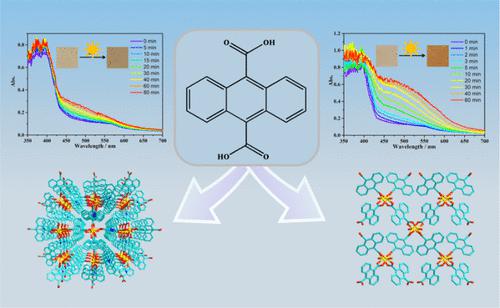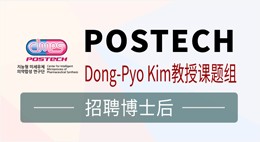当前位置:
X-MOL 学术
›
Inorg. Chem.
›
论文详情
Our official English website, www.x-mol.net, welcomes your
feedback! (Note: you will need to create a separate account there.)
Photoactive Anthracene-9,10-dicarboxylic Acid for Tuning of Photochromism in the Cd/Zn Coordination Polymers
Inorganic Chemistry ( IF 4.3 ) Pub Date : 2022-07-07 , DOI: 10.1021/acs.inorgchem.2c01019
Qi Li 1 , Qian Zhang 1 , Zhen-Zhen Xue 1 , Ji-Xiang Hu 1 , Guo-Ming Wang 1
Inorganic Chemistry ( IF 4.3 ) Pub Date : 2022-07-07 , DOI: 10.1021/acs.inorgchem.2c01019
Qi Li 1 , Qian Zhang 1 , Zhen-Zhen Xue 1 , Ji-Xiang Hu 1 , Guo-Ming Wang 1
Affiliation

|
Electron transfer photochromic materials with photo-triggered radicals have received huge interest from chemists due to their potentialities in anticounterfeiting, displays, energy conversion, and information storage. However, utilizing the sole carboxylic acid to synthesize novel electron transfer photochromic species is still confronted with huge challenges. Herein, an acentric three-dimensional network Cd2(ADC)2(DMF)2(H2O) (1; ADC = anthracene-9,10-dicarboxylate; DMF = N,N-dimethylformamide) and a two-dimensional layer Zn(ADC)(H2O)·DMA·H2O (2; DMA = N,N-dimethylacetamide) were synthesized and characterized via a photoactive H2ADC ligand. Both compounds exhibited electron transfer photochromism with the formation of radical photoproducts at the solid state, which was revealed by IR, UV–Vis absorption, photoluminescence and electron spin resonance spectra, and magnetic susceptibility measurements. Density functional theory calculations for 1 showed that the coloration process is a metal-assisted ligand-to-ligand electron transfer process between adjacent ADC molecules, and photogenerated stable radicals are delocalized over the ADC components. Compared with 1, the shorter distances between ADC components via coordination bonds promoted 2 to exhibit a higher coloration efficiency and larger quantity of photogenerated radicals. Furthermore, both compounds showed unexpected radical-actuated photochromism in aqueous solution. This work showed that the carboxylic acid ligands, without viologen acceptors, could construct the electron transfer photochromic complexes, showing a novel kind of ligand for the design of hybrid photochromic materials.
中文翻译:

用于调节 Cd/Zn 配位聚合物光致变色的光活性蒽 9,10-二羧酸
具有光触发自由基的电子转移光致变色材料因其在防伪、显示、能量转换和信息存储方面的潜力而受到化学家的极大兴趣。然而,利用单一羧酸合成新型电子转移光致变色物质仍面临巨大挑战。在此,无心三维网络 Cd 2 (ADC) 2 (DMF) 2 (H 2 O) ( 1 ; ADC = anthracene-9,10-dicarboxylate; DMF = N , N -dimethylformamide) 和二维层Zn(ADC)(H 2 O)·DMA·H 2 O ( 2 ; DMA = N ,N-二甲基乙酰胺)通过光活性 H 2 ADC 配体合成和表征。两种化合物都表现出电子转移光致变色,并在固态下形成自由基光产物,这通过 IR、UV-Vis 吸收、光致发光和电子自旋共振光谱以及磁化率测量来揭示。1的密度泛函理论计算表明,着色过程是相邻ADC分子之间的金属辅助配体-配体电子转移过程,光生稳定自由基在ADC组分上离域。与1相比,ADC 组件之间通过配位键的更短距离促进了2表现出更高的着色效率和更多的光生自由基。此外,两种化合物在水溶液中都表现出意想不到的自由基驱动的光致变色。这项工作表明,在没有紫精受体的情况下,羧酸配体可以构建电子转移光致变色复合物,为设计杂化光致变色材料提供了一种新型配体。
更新日期:2022-07-07
中文翻译:

用于调节 Cd/Zn 配位聚合物光致变色的光活性蒽 9,10-二羧酸
具有光触发自由基的电子转移光致变色材料因其在防伪、显示、能量转换和信息存储方面的潜力而受到化学家的极大兴趣。然而,利用单一羧酸合成新型电子转移光致变色物质仍面临巨大挑战。在此,无心三维网络 Cd 2 (ADC) 2 (DMF) 2 (H 2 O) ( 1 ; ADC = anthracene-9,10-dicarboxylate; DMF = N , N -dimethylformamide) 和二维层Zn(ADC)(H 2 O)·DMA·H 2 O ( 2 ; DMA = N ,N-二甲基乙酰胺)通过光活性 H 2 ADC 配体合成和表征。两种化合物都表现出电子转移光致变色,并在固态下形成自由基光产物,这通过 IR、UV-Vis 吸收、光致发光和电子自旋共振光谱以及磁化率测量来揭示。1的密度泛函理论计算表明,着色过程是相邻ADC分子之间的金属辅助配体-配体电子转移过程,光生稳定自由基在ADC组分上离域。与1相比,ADC 组件之间通过配位键的更短距离促进了2表现出更高的着色效率和更多的光生自由基。此外,两种化合物在水溶液中都表现出意想不到的自由基驱动的光致变色。这项工作表明,在没有紫精受体的情况下,羧酸配体可以构建电子转移光致变色复合物,为设计杂化光致变色材料提供了一种新型配体。

































 京公网安备 11010802027423号
京公网安备 11010802027423号